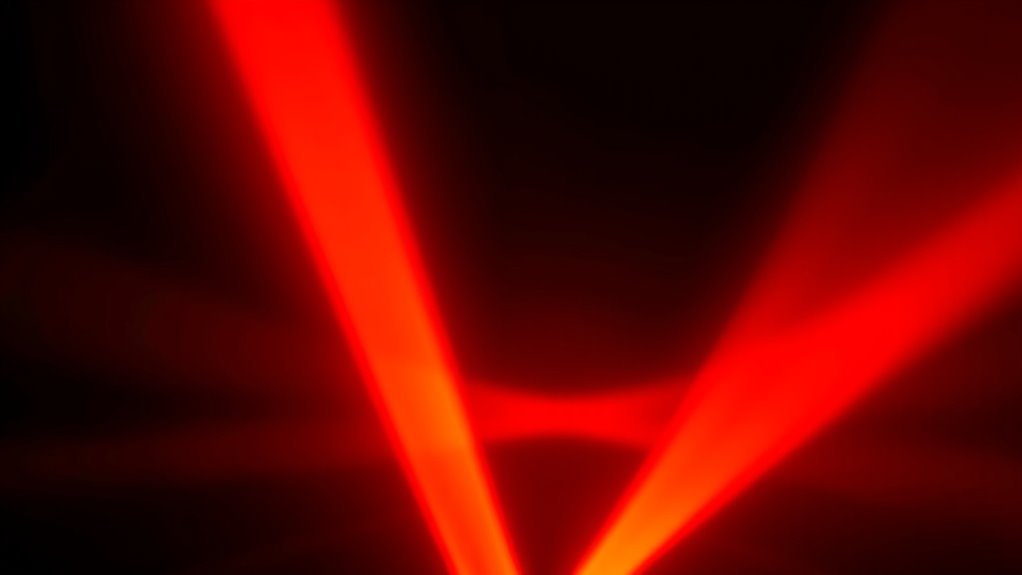Red light wavelengths range from about 630 to 660 nanometers, giving a deep to vibrant red color, depending on the exact wavelength. Wavelengths closer to 630 nm appear a deeper red, while 660 nm creates a vivid crimson hue. Beyond visible red light, near-infrared wavelengths extend from 810 to 850 nm and aren’t visible but are used in medical imaging and remote sensing. Exploring these ranges helps you understand how light interacts with objects and tissues. Keep going to uncover more fascinating details about these wavelengths.
Key Takeaways
- Red light wavelengths range from 630 to 660 nm, influencing the hue and how we perceive deep to vivid red colors.
- Near-infrared wavelengths (810–850 nm) are outside visible range but used in medical imaging and remote sensing.
- Light sources like LEDs and lasers emit within these specific ranges, affecting their applications and interactions.
- Wavelength differences impact how light interacts with objects, tissues, and biological processes, affecting effectiveness in various uses.
- Understanding these ranges helps select appropriate light for visual, biological, or technological purposes.

Have you ever wondered what determines the color of red light? It’s primarily about the wavelength of the light waves. Wavelengths are the distance between successive peaks of a wave, and in the case of light, they directly influence the color you perceive. For red light, this wavelength falls within specific ranges, mainly between 630 to 660 nanometers (nm). That span is what your eyes interpret as the familiar red hue. But there’s more to it. Some sources also include near-infrared wavelengths, from about 810 to 850 nm, which are just outside the visible spectrum but still relevant in certain applications like medical therapies or remote sensing. These longer wavelengths are just beyond what humans can see, yet they possess similar properties and are often associated with red light in technological contexts. Additionally, the spectral purity of the light can influence how vivid or saturated the red appears to our eyes.
Red light is mainly determined by wavelengths between 630 and 660 nm, with near-infrared extending beyond 810 nm.
The visible red light spectrum, from 630 to 660 nm, is where most of your everyday red light comes from. Think of a standard laser pointer or an LED indicator; they typically emit light within this range. The shorter end, around 630 nm, appears a slightly deeper red, while approaching 660 nm gives a more vivid, crimson tone. The difference in wavelength, although small, influences how the light interacts with objects, including how it penetrates tissues or reflects off surfaces. This is especially relevant in applications like phototherapy or plant growth lights, where specific wavelengths are chosen for their biological effects.
Beyond the visible spectrum, wavelengths from 810 to 850 nm are considered near-infrared. These are invisible to the human eye but are vital in technology and science. For instance, infrared LEDs used in remote controls emit light around this range, allowing signals to be sent without visible light being emitted. In medical fields, near-infrared wavelengths penetrate tissues more deeply, making them useful for imaging or therapy. Despite being outside our visual perception, these wavelengths share similar electromagnetic properties with visible red light, making them part of the broader red light family.
Understanding these wavelength ranges helps you grasp why different red lights serve various purposes. Whether it’s the vivid reds of everyday electronics or the deeper infrared used in science and medicine, the key is the wavelength. Slight variations can change how the light interacts with matter, influences biological processes, or transmits signals. So, next time you see a red laser or use a red LED, remember that its color and function are rooted in these specific wavelength ranges, bridging the gap between what you see and the invisible light beyond.
Frequently Asked Questions
How Do Red Light Wavelengths Affect Skin Healing Processes?
Red light wavelengths boost your skin healing by penetrating deep layers, stimulating cellular activity. They increase blood flow, promote collagen production, and reduce inflammation, speeding up repair. When you use red light therapy, you’re encouraging your body to produce new cells faster and improve tissue regeneration. This process helps your skin recover more quickly from injuries, scars, or damage, making your healing process more efficient and effective.
Are There Differences in Red Light Wavelengths for Different Skin Types?
Yes, there are differences in red light wavelengths for different skin types. You might find that slightly shorter wavelengths, around 630 nm, work better for lighter skin, while longer wavelengths, near 850 nm, penetrate deeper and are more effective for darker skin. Adjusting the wavelength based on your skin type helps optimize healing and reduces potential irritation, ensuring you get the best results from red light therapy.
Can Red Light Wavelengths Penetrate Through Clothing or Barriers?
Red light wavelengths generally can’t penetrate clothing or barriers effectively. When you use red light therapy, the light needs direct contact with your skin for ideal absorption. Clothing, especially thick or dark fabrics, blocks most of the wavelengths, preventing them from reaching your tissues. For best results, make sure you expose your skin directly, as barriers considerably diminish the therapy’s effectiveness.
What Role Do Red Light Wavelengths Play in Plant Growth?
Red light wavelengths are essential for plant growth, especially during photosynthesis, where they help convert light into energy. Did you know that red light can stimulate flowering and fruiting in plants? You play a key role by providing these wavelengths through grow lights, enhancing plant development indoors or in low-light conditions. By understanding these wavelengths, you can optimize your plants’ health, ensuring faster growth and higher yields.
How Do Red Light Wavelengths Influence Circadian Rhythms?
Red light wavelengths influence your circadian rhythms by signaling your body’s internal clock. When you’re exposed to red light, it helps regulate your sleep-wake cycle, promoting alertness during the day and sleep at night. It also affects hormone production, like melatonin, which controls sleepiness. By controlling exposure to red light at specific times, you can improve your overall sleep quality and maintain a healthy daily rhythm.
Conclusion
Understanding red light wavelengths helps you make informed choices about their benefits. Whether it’s the 630–660 nm range for skin health or 810–850 nm for deeper tissue penetration, knowing the differences empowers you to optimize their use. Remember, “a little knowledge is a dangerous thing,” so stay curious and informed. Embrace the power of red light wisely, and you’ll harness its full potential for your well-being.









